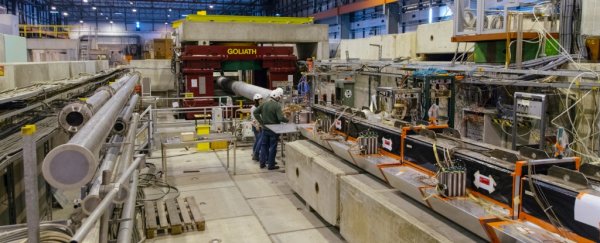Scientists will soon embark on a quest to solve one of the biggest mysteries in modern physics, by hunting down evidence of a new particle called the 'dark photon'.
Dark photons are hypothesised to be the bridge between visible matter - which makes up all of the things around us - and dark matter, the mysterious invisible matter that's thought to be lurking throughout the Universe. If they can find it, it will change our understanding of physics forever.
Based on the fact that there's more gravity holding our Universe together than can be accounted for by visible matter, physicists think that roughly 85 percent of the matter in our Universe is dark.
It's hypothesised that this aptly-named dark matter remains hidden because it doesn't interact with the electromagnetic spectrum, making it invisible to our current instruments.
But for the dark matter hypothesis to hold up, there must be another unknown force at work in the Universe - besides gravity - through which this dark matter could interact with visible matter.
Researchers predict that this force could be made up of something called 'dark photons', which facilitate interactions between dark and visible matter. These dark photons could transmit this new, unknown force in much the same way that a photon of light transmits the electromagnetic force.
If that all sounds awfully confusing, you can think of a dark photon as a mediator between two people (visible and dark matter) who can't communicate with each other. A Google Translator of particle physics, if you will.
"To use a metaphor, an otherwise impossible dialogue between two people not speaking the same language (visible and dark matter) can be enabled by a mediator (the dark photon), who understands one language and speaks the other one," explains spokesman Sergei Gninenko from the European Organisation for Nuclear Research (CERN) .
Despite many scientists supporting this hypothesis, there's one problem: no one has actually found a dark photon as yet, and until we do, no one can say for sure what's going on.
But that all might soon change, because an international team of researchers from CERN - the same organisation that hunted down the elusive Higgs boson - are preparing to perform experiments that could actually find a dark photon.
The project, dubbed NA64, will attempt to find signatures of 'visible-dark' interaction using the well-known concept of the conservation of energy, which states that the total energy of a closed system will remain constant (conserved) over time.
The general idea here is that if the team creates an isolated system, they can accurately measure the amount of energy inside it.
After creating photons from beams of electrons inside a particle accelerator, they can see if the amount of energy changes, signalling that something unseen is acting inside the system - possibly a dark photon.
"A beam of electrons, whose initial energy is known very precisely, is aimed at a detector. Interactions between incoming electrons and atomic nuclei in the detector produce visible photons.
The energy of these photons is measured and it should be equivalent to that of the electrons. However, if the dark photons exist, they will escape the detector and carry away a large fraction of the initial electron energy."
Based on how much energy is lost, if any, the team will be able to ascertain a 'signature' of the mysterious dark photons, suggesting that they might exist.
It's important to note that finding a signature like this would only be a hint of their existence, though potentially a very strong one.
Until a dark photon is somehow observed directly - in a similar way that CERN researchers detected the Higgs boson - the work will remain purely hypothetical.
But finding the signature is the first step towards finally figuring out dark matter, and how the rest of the Universe works. Because if our understanding of dark matter falls apart, so does our understanding of gravity, and many of the other forces that govern our Universe.
There's no word on when the NA64 experiments will produce results, but we'll be eagerly waiting to see what happens next.
